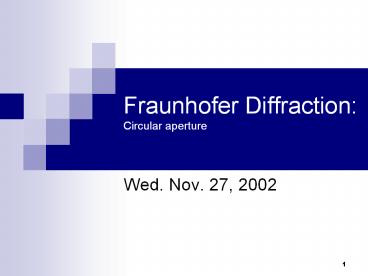Fraunhofer Diffraction: Circular aperture - PowerPoint PPT Presentation
Title:
Fraunhofer Diffraction: Circular aperture
Description:
Fraunhofer Diffraction: Circular aperture Wed. Nov. 27, 2002 Fraunhofer diffraction from a circular aperture Fraunhofer diffraction from a circular aperture ... – PowerPoint PPT presentation
Number of Views:248
Avg rating:3.0/5.0
Title: Fraunhofer Diffraction: Circular aperture
1
Fraunhofer Diffraction Circular aperture
- Wed. Nov. 27, 2002
2
Fraunhofer diffraction from a circular aperture
?
y
?
P
r
x
?
Lens plane
3
Fraunhofer diffraction from a circular aperture
Path length is the same for all rays ro
Do x first looking down
Why?
?
4
Fraunhofer diffraction from a circular aperture
Do integration along y looking from the side
?
P
R
?
y0
ro
?
?
-R
r ro - ysin?
5
Fraunhofer diffraction from a circular aperture
Let
Then
6
Fraunhofer diffraction from a circular aperture
The integral
where J1(?) is the first order Bessell function
of the first kind.
7
Fraunhofer diffraction from a circular aperture
- These Bessell functions can be represented as
polynomials - and in particular (for p 1),
8
Fraunhofer diffraction from a circular aperture
- Thus,
- where ? kRsin? and Io is the intensity when ?0
9
Fraunhofer diffraction from a circular aperture
- Now the zeros of J1(?) occur at,
- 0, 3.832, 7.016, 10.173,
- 0, 1.22?, 2.23?, 3.24?,
- kR sin? (2?/?) sin?
- Thus zero at
- sin ? 1.22?/D, 2.23 ?/D, 3.24 ?/D,
10
Fraunhofer diffraction from a circular aperture
The central Airy disc contains 85 of the light
11
Fraunhofer diffraction from a circular aperture
D
?
sin? 1.22?/D
12
Diffraction limited focussing
- sin? 1.22?/D
- The width of the Airy disc
- W 2fsin? ? 2f ? 2f(1.22?/D) 2.4 f?/D
- W 2.4(f)? gt ? f gt 1
- Cannot focus any wave to spot with dimensions lt ?
f
D
?
?
13
Fraunhofer diffraction and spatial resolution
- Suppose two point sources or objects are far away
(e.g. two stars) - Imaged with some optical system
- Two Airy patterns
- If S1, S2 are too close together the Airy
patterns will overlap and become indistinguishable
S1
?
S2
14
Fraunhofer diffraction and spatial resolution
- Assume S1, S2 can just be resolved when maximum
of one pattern just falls on minimum (first) of
the other - Then the angular separation at lens,
- e.g. telescope D 10 cm ? 500 X 10-7 cm
- e.g. eye D 1mm ?min 5 X 10-4 rad
15
Polarization
16
Matrix treatment of polarization
- Consider a light ray with an instantaneous
E-vector as shown
y
Ey
x
Ex
17
Matrix treatment of polarization
- Combining the components
- The terms in brackets represents the complex
amplitude of the plane wave
18
Jones Vectors
- The state of polarization of light is determined
by - the relative amplitudes (Eox, Eoy) and,
- the relative phases (? ?y - ?x )
- of these components
- The complex amplitude is written as a two-element
matrix, the Jones vector
19
Jones vector Horizontally polarized light
The arrows indicate the sense of movement as the
beam approaches you
- The electric field oscillations are only along
the x-axis - The Jones vector is then written,
- where we have set the phase ?x 0, for
convenience
The normalized form is
20
Jones vector Vertically polarized light
- The electric field oscillations are only along
the y-axis - The Jones vector is then written,
- Where we have set the phase ?y 0, for
convenience
The normalized form is
21
Jones vector Linearly polarized light at an
arbitrary angle
- If the phases are such that ? m? for m 0,
?1, ?2, ?3, - Then we must have,
- and the Jones vector is simply a line inclined
at an angle ? tan-1(Eoy/Eox) - since we can write
?
The normalized form is
22
Jones vector and polarization
- In general, the Jones vector for the arbitrary
case - is an ellipse
y
Eoy
b
a
?
x
Eox

